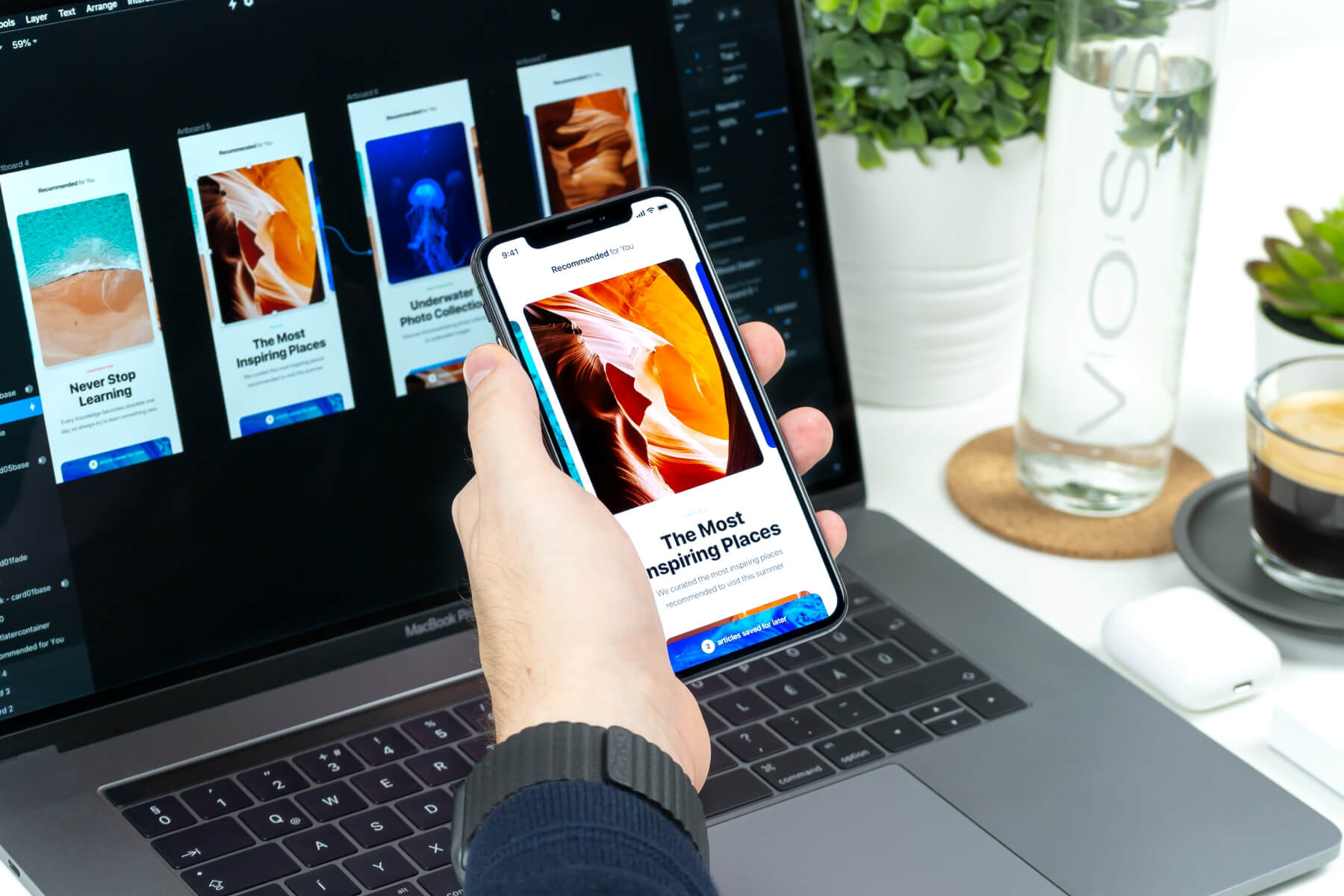How to design an app in 2023 (costs, best tools & examples)
February 2, 2023
Mobile phones pose more constraints than desktop devices. You have limited screen space, fewer characters to play with, and sloppy user fingers to keep in mind.
Using smartphone native features and UX/UI best practices, great mobile app design gives users a convenient path towards achieving their goals. Whether it’s hailing a cab, booking a hotel, or ordering a new shirt.
This guide break downs the mobile app development process into repeatable steps, paired with helpful examples, tools, and cost estimates.
Why Good UX is a Must-Have for Mobile Apps
Great mobile app design makes users choose your app over others and builds usage habits.
The likelihood of a customer to continue doing business with a brand is 2.7 times higher when they have a high-quality experience.
Poor mobile app design, in turn, is easy to notice because it costs you users and revenue.
✈️ In the travel industry, 91% of users abandon in-app bookings primarily because of “bad customer experience.”
Finally, mobile apps help acquire users faster than mobile websites:
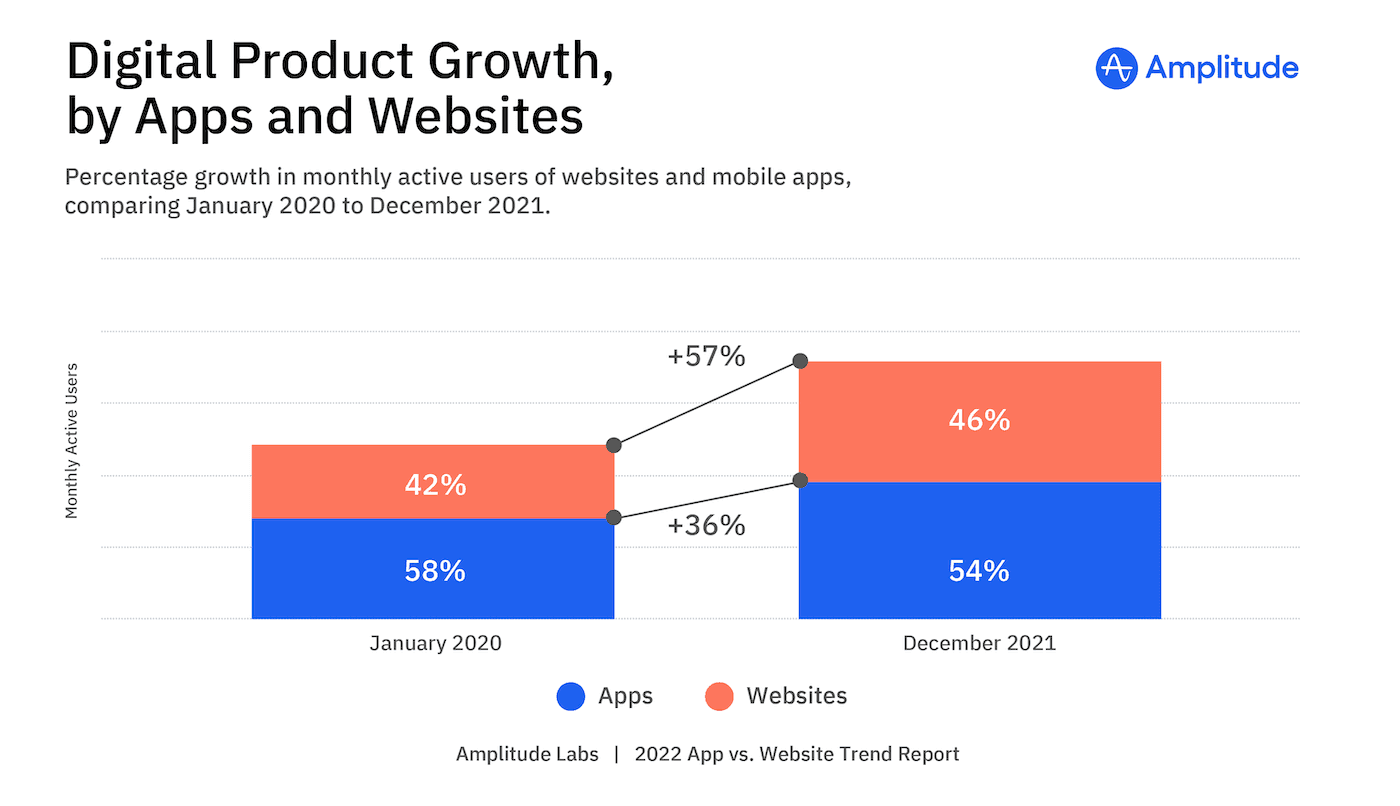
Source: Aptitude Labs 2022 Study.
Ultimately, in the words of Charlie Claxton, Head of UX, at Amazon: “UX yields a return between $2 and $100 on every dollar invested.”
The yields come from faster user acquisition, lower churn, and higher customer lifetime value.
How to Design an App Step-by-Step
Mobile user experience (UX) is the grand sum of all app layout, navigation, and user interface decisions you make based on user research and feedback.
To make the right call each time, follow these steps:
Do in-depth user research
Create app wireframes
Hire mobile app designers
Develop interactive app prototype
Gather user feedback
Prepare finalized app designs for handover to developers
1. Line Up Your User Research
Putting yourself in the user’s shoes is the key to transforming your app idea into an actual product.
Think about this:
Why would people want to use your product?
What features do they expect to see?
What will a standard user journey look like?
To get answers, you’ll need to organize your earlier market research and target audience research in a designer-friendly format.
Packaged collected information into:
Ideal user personas. Fictional user profiles based on generalized demographics and psychographics data.
Product hypothesis and assumptions. Short text snippets about intended app use cases and interaction patterns.
Must-have features. Document these as a high-level list, paired with user stories.
Competitive landscape. Other apps you’d like to mimic, top, or avoid copying.
To get richer data, conduct qualitative and quantitative mobile user research — user interviews, observational studies, or online surveys.
2. Create Low-Fi Wireframes
A low-fi wireframe is a schematic representation of your app’s main screens. It must showcase the layout of the main user interface elements.
Wireframing is essential for testing your user flow assumptions before the app development begins.
The two types of wireframes are:
Low fidelity (low-fi) wireframe is a blueprint of the main screens in grayscale without well-defined visual elements.
High fidelity (hi-fi) wireframe is a colorful, detailed representation of your app layout with main user screens, branding, and other graphic design elements.
Low-fi wireframes are easy to make, even for non-designers. You can use a visual app builder like Appy Pie or a prototyping tool like Balsamiq to create simple wireframes.
Then take your concept to mobile app designers for refinement.
3. Hire Mobile UX Designers
You must get your app’s design right to launch a successful app. Or else you’ll struggle with user acquisition, activation, and retention.
That’s where UX and UI designers come into play.
An experienced UX/UI designer can help:
Locate gaps in your user flows and suggest extra UI elements
Minimize friction at crucial stages like account registration or checkout
Design proper information architecture and optimal navigation paths
Add additional interactive elements which ease product adoption and usage
Wire in “delight” to make app users inspired, satisfied, and amazed with your product
In other words: they build your app around the hierarchy of user needs.
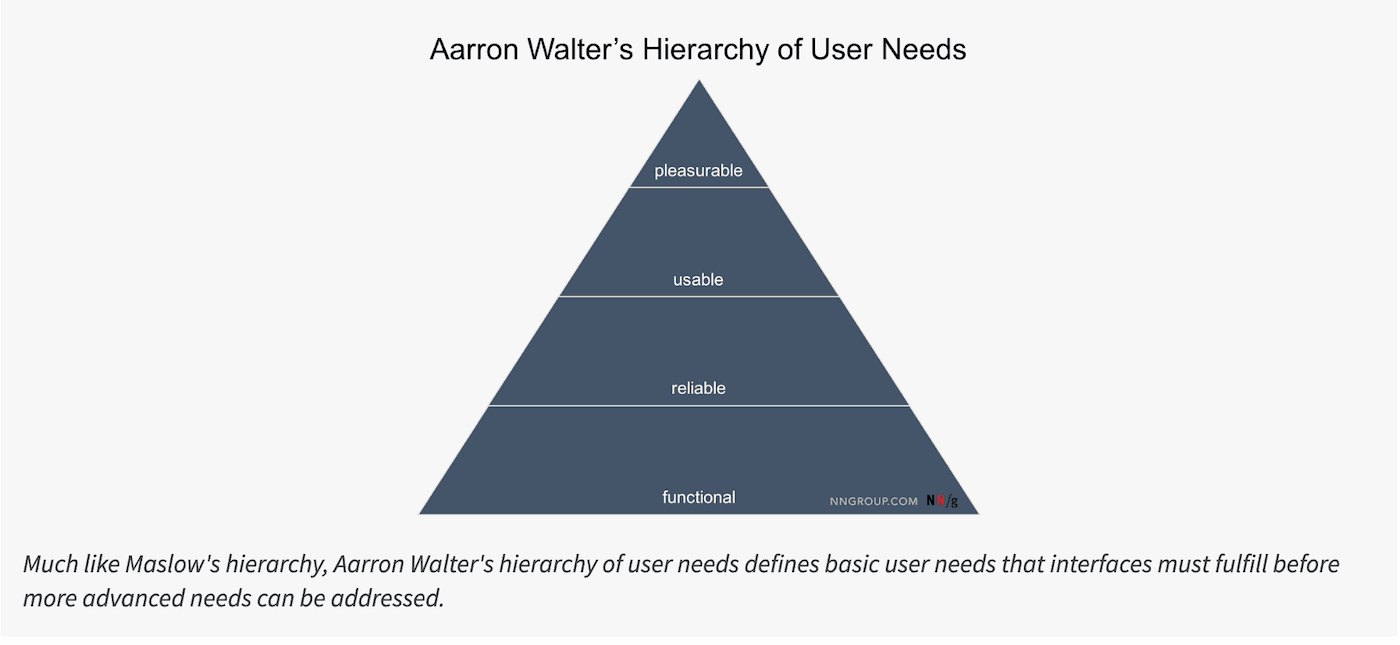
Aaron Walter's Hierarchy of User Needs. Source: Nielsen Norman Group.
Many entrepreneurs choose to hand over the app design process to specialists. That was the case with Slack. The startup engaged professional app designers to validate their wireframes and turn the sketches into a sleek product we all now use.
How Much Does It Cost to Design a Mobile App?
Mobile app design costs vary based on: design specifications (overall business logic, number of screens, the complexity of user flow, extra graphic design elements, etc.) and the type of team working on the product.
58% of businesses say “complexity” is the most influential factor in app development costs, followed by “number of features” (50%) and “business logic” (50%).
Here’s how app design costs change based on the app complexity:
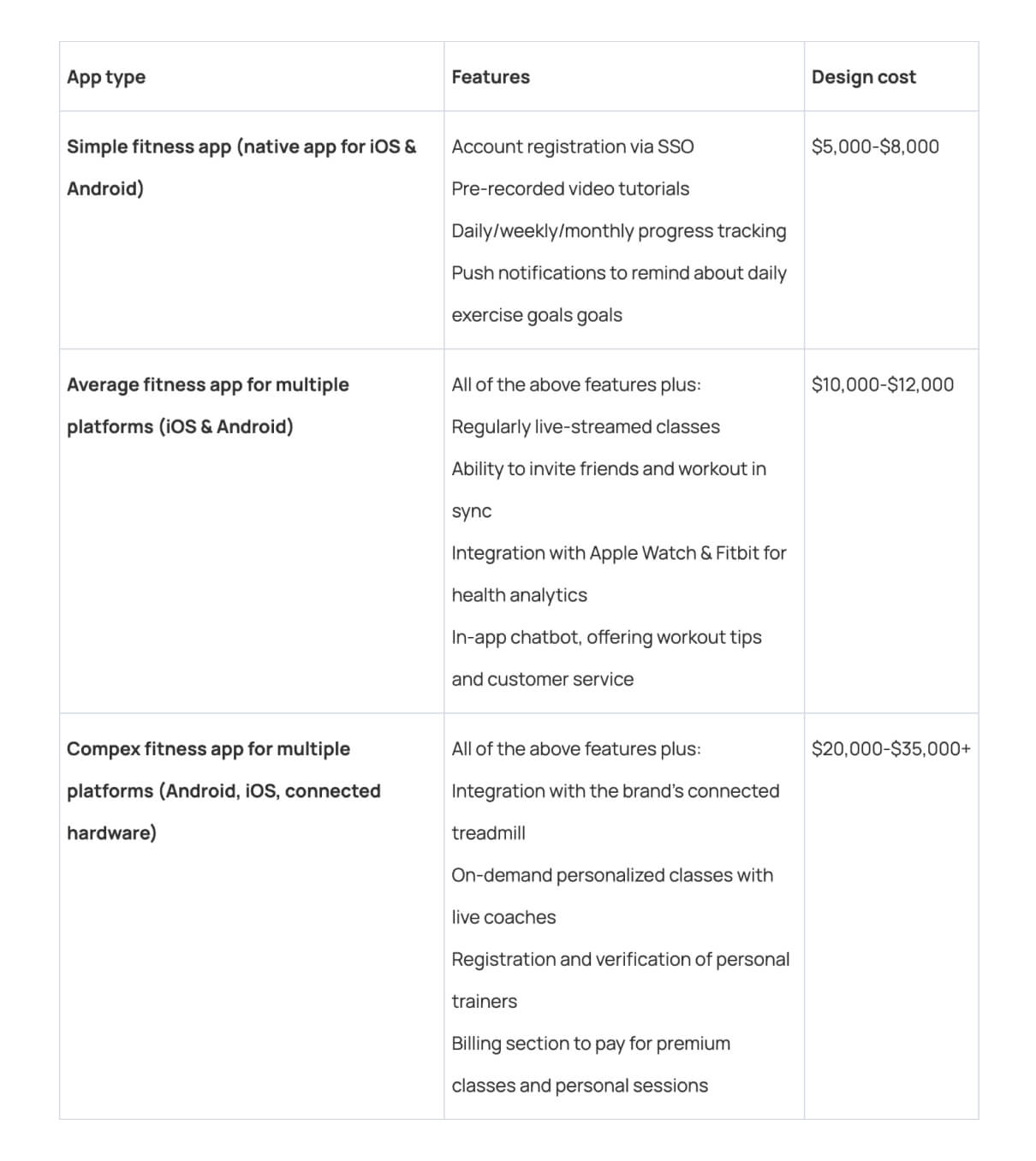
App design costs also vary depending on whether you design the app in-house or rely on the external workforce — a design agency, mobile app development company, or freelancers.
Hiring in-house UX designers might seem like the cheapest option, but it’s not always the case.
For a moderately complex project, you’ll need:
UX design lead. Average salary: $135,799 per year.
Two UX/UI designers. Average salary: $106,330 per year.
You should also factor in recruiting costs (an extra $4,600+ per person) and overall employee overheads (1.2-1.4 times their annual salary) for each hire.
In high cost of living areas with a booming tech market (New York, San Francisco, London, or Berlin), salary and overhead costs will be above the national averages because you’ll compete with other employers for talent.
Freelance UX designers are the second most frequent choice.
Freelance mobile app designers are a good option when you need to:
Augment an in-house UX team with extra hands
Design screens for a minimum viable product (MVP)
Make an early app prototype for investors
Get a consultation or audit of a particular user flow
Hiring freelancers to design a complex app mostly makes sense if you can take on the role of Lead UX and guide the team through the entire project.
That leaves most entrepreneurs with two options: an app design agency or a mobile app development company. Both options come with a higher initial price tag.
But you can balance the costs by:
Selecting a provider in a lower cost of living area or country
Outsourcing app design and development process to the same company
Prioritizing boutique app development firms over multinationals (as they can afford lower profit margins)
4. Collaborate On an Interactive Prototype
Prototyping is the next step of the app design process.
Your main goal: help your app designers understand your app requirements — overall logic, user goals, competitive features, and standard user flows.
Prototyping is a collaborative process. You need to provide a detailed description of your idea while the UX designers pitch different design ideas.
To start iterating, complete the following steps.
Analyze Competing Apps
Your product has to be better than existing apps.
To understand what your competition does well (or poorly), analyze UX benchmarks in your industry.
For instance, Baymard Institute has in-depth research into native ecommerce app UX performance.
Spoiler: few apps score universality high on all parameters.
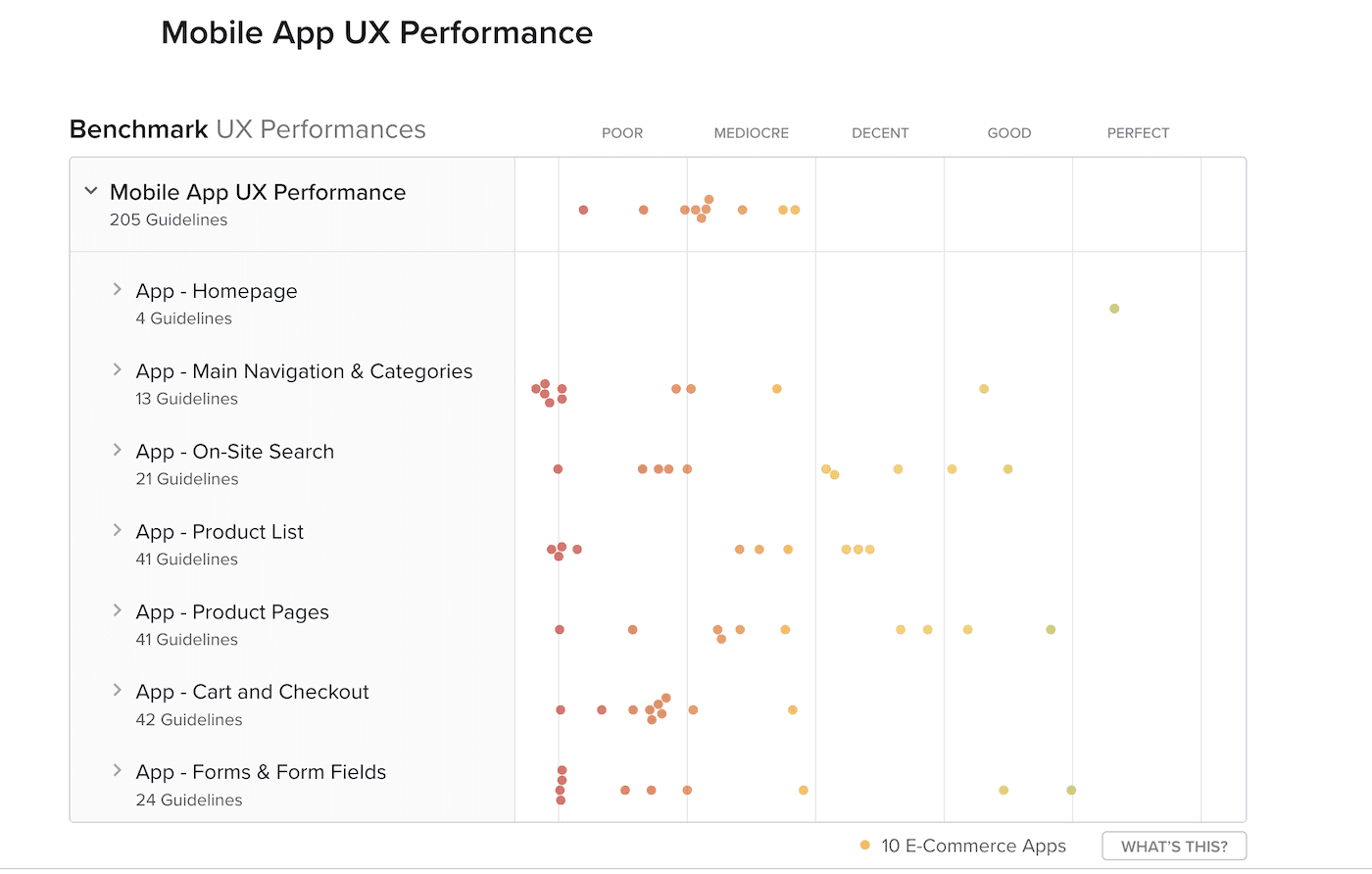
Mobile App UX Performance. Source: Baymard.
The institute also curates great mobile app designs across page types, such as search results, shopping carts, and payment forms.
Analyze what cream of the crop players do well and share those references with your team.
Separately, gather consumer reviews of top competitor apps. Pay attention to users’ complaints or requests for extra features. Think about how you’ll avoid the same app design goofs to make your product better and more convenient.
Collect Mobile Design Patterns
Create a library of mobile app designs and user interface elements you want for your app.
These can be examples of good navigation, a smooth account opening process, creative splash screens, or general notes on preferred color pallets, button sizes, etc.
Here are several great ways to discover mobile app design patterns:
📐 Pro tip: Don’t forget about official design guidelines for different platforms. Human Interface Guidelines for iOS apps. Material design principles for Android apps.
If your app designer pushes back on some suggestions by bringing up either of these, go with their idea. Users and app stores may reject your product if you don’t follow official design guidelines.
Decide on Your App Design Aesthetics
To guide your designer at the prototyping stage, provide clear references for graphic design.
Share your preferences on:
Brand colors
Typography
Illustrations or animations
General vibe and aesthetics
To make your mobile design look fresh, you can use an emerging app design trend such as brutalist design, asymmetric menus, or isometric elements.
Here are several examples of creative app design to get you inspired!
Rabit Habit Tracking App
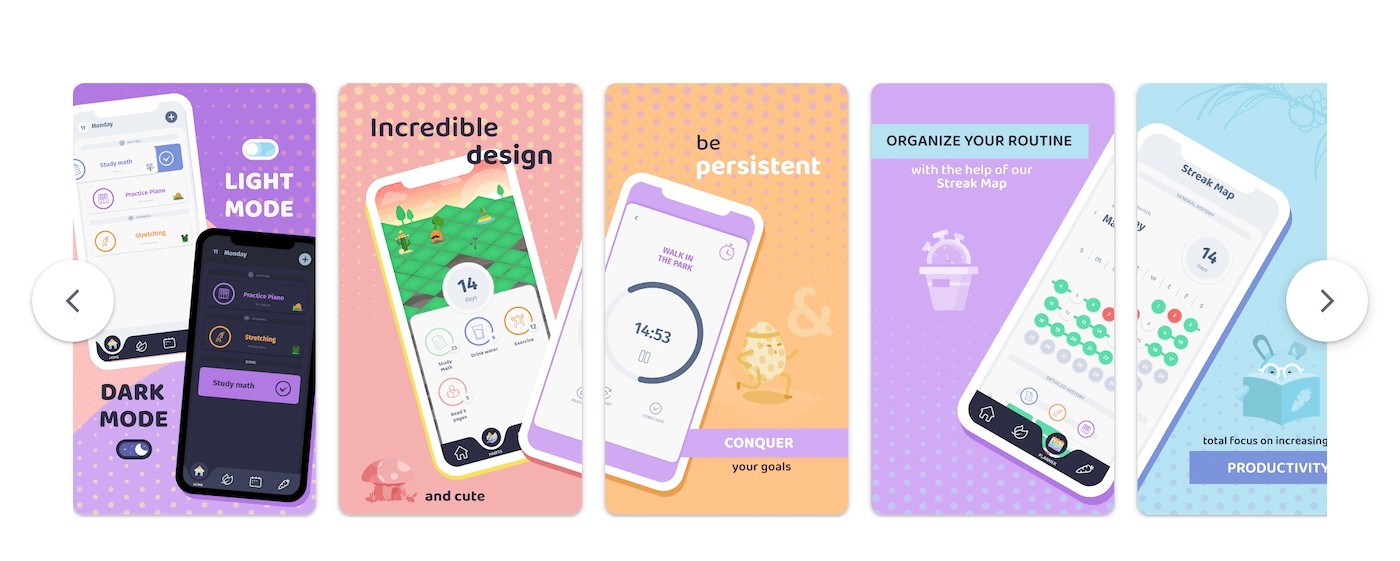
Rabit app. Source: Google Play.
Rabit is a 2021 winner of the “Best of Google Play Store” award in the Everyday Essentials category. The app sports a trending pastel color pallet with cute animal illustrations and interactive elements.
The app idea isn’t revolutionary, but its original design and uber-delightful UX won over many users.
Among Us! Social Gaming App

Among Us! game. Source: Apple App Store.
Among Us! topped app store charts in 2021 as a hugely popular social game of whodunit.
This app design is reminiscent of early 1990s MS-DOS games, offering app users a mix of nostalgia and absurdity. It proves that not all mobile apps must be conventionally pretty to succeed.
Flowkey Piano Learning App

Flowkey iOS app. Source: Apple App Store.
Flowkey iOS app is an excellent example of how you can maximize mobile screen space without visually overloading users.
The team takes advantage of native mobile device features such as screen orientation, microphone, and MIDI connection to deliver an effective learning experience.
A dark color scheme also makes this iPhone app look chic, sleek, and different from other educational apps.
5. Collect Feedback on Your Prototype
Your team is done designing all the features. Before the app development begins, you need to collect one last round of user feedback.
Why? Because making user interface changes at the later stages will stretch the app development timeline and balloon the costs.
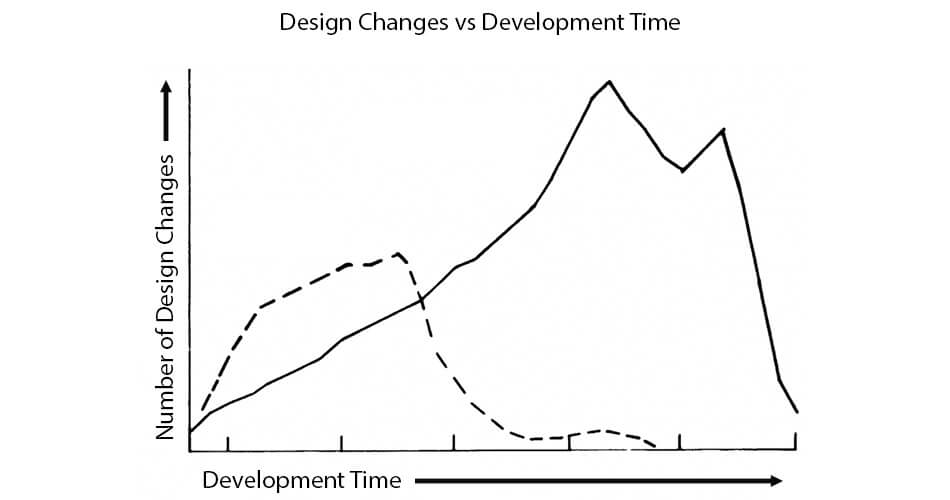
Design Changes vs Development Time. Source: Fictiv.
To avoid such scenarios, validate your app prototype with the target audience.
Assemble a representative user group. Select real users who perfectly fit into your ideal target audience. For example, a 25-year-old female, who took music classes at school for 3 years, now wants to resume practice.
And add a couple more “extreme” users – people who might use your product in non-standard ways.
For example, a guy who never played the piano but aggressively learned a new tune before his wedding in a month. Such extreme users can help you uncover issues regular folks might also have but do so faster.
Align your validation methods with your goals. For example, if you want to validate your usability assumptions (e.g., checkout process convenience), write down a set of tasks a user needs to complete during an observational test.
If you want to validate product-market fit, prepare a list of open-ended questions for in-person interviews.
Be open to feedback. Treat mobile app UX as a continually evolving project. You might not address all users’ needs in your MVP version.
But you can iterate on them later. Ask your test group to contribute their ideas for extra app features. Asking, “what do you think about X?” is an easy way to elicit more valuable critics and additional app ideas.
6. Prepare Your App Design for Development Handoff
Handoff marks the end of the design process.
At this point, your UX people did their best — and now need to transfer their knowledge to mobile app developers.
Miscommunication between designers and developers can lead to costly re-works and negatively affect the product’s success.
Good project documentation and design specs are the two pillars of successful design handoffs.
To ensure your development team has all the information they need, prepare the following:
The final prototype and individual screens providing developers with a visual reference of the final product.
User flow maps explaining the overall app logic possibilities and edge cases. These can be presented as chart flow diagrams, wire flows, or screen flows.
Design style guide documenting your app’s colors, typography, and other essential graphic design elements. You should also include visual specs on styles and spacings.
The component library including notes, references, and commentary on various design elements such as buttons, forms, modals, etc.
User story notes with helpful text notes designers leave for developers to implement the solution.
UX copy separately packaged all the in-app messages and copy for different screens. Don’t forget the micro-copy for tooltips and tab bar.
This information helps developers understand the app concept and logic behind specific design choices. Then make more informed decisions when it comes to coding.
Design handoff can be tedious as you have to document and communicate a lot! Try the following apps to create a smoother design handoff process:
UXPin is a collaborative UX prototype tool with excellent commenting and annotation features.
Zeplin helps automate visual specs generation, annotation, and cross-team collaboration on finalized app designs.
Avocode lets you import, store, and collaborate on all design files through one feature-packed workspace.
Conclusions
You’ve made it through the entire design process!
Take a deep breath, sip coffee, and read about organizing the mobile app development process.
Common questions about mobile app design
Still have questions? We’ve got some more answers!
What makes an app good design?
According to Aarron Walter’s hierarchy of user needs, a great app is functional, reliable, usable, and delightful.
If an app is visually appealing but lacks a purpose, its aesthetic qualities will remain unappreciated.
Likewise, if an app has a function that looks pretty but glitches, people will abandon it. Hence, native apps’ design must satisfy all four criteria to be successful.
How many screens should an app have?
The ideal number of screens depends on your product type and complexity.
A simple note-taking app needs 3-5 screens max to be useful.
But a mobile banking app needs 10-15 different screens to bring value to the user. Your standard user flow will determine how many app screens you’ll need for each feature and in total.
What makes a bad app design?
Crowded, cluttered interfaces and complete disregard for mobile OS design guidelines are two common reasons behind lousy app design.
The official design guidelines – Material Design and Human Interface Guidelines – provide an exhausting list of dos and don’ts for native apps.
The common design don’ts for mobile apps include ignoring user touch gestures, excessive zoom usage, small button sizes, accordion top bar navigation, and aggressive contrast usage.
How can I improve my mobile app design?
To improve your mobile app design, try these “hot fixes” for your app:
Reduce the number of clicks required to register for an account
Reduce the number of form fields and pre-populate these when possible
Add Apple Pay integration for iPhone apps and Google Pay for Android apps to speed up the checkout
Suggest auto-complete for free hand form inputs
Add alternative navigation paths for a problematic user flow
What makes an app look modern?
Modern mobile apps are designed for devices with high-res screens, powerful cameras, and sensing technologies.
Take advantage of biometrics-enabled features for user identification or log-ins. Use phone data – sensors, location-based services – to add extra interactivity to your app look.
For example, personalize the app interface based on the user location.
